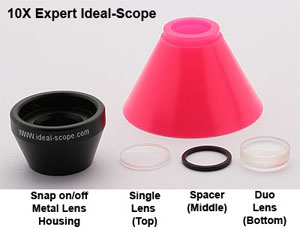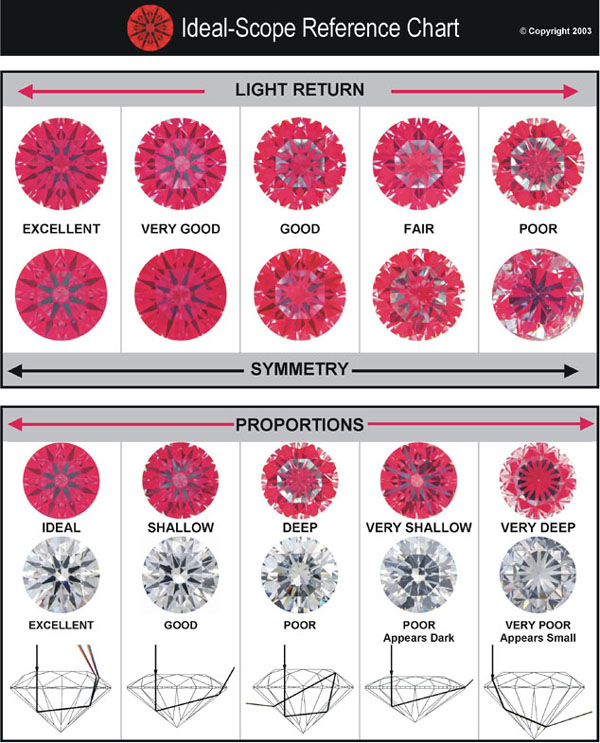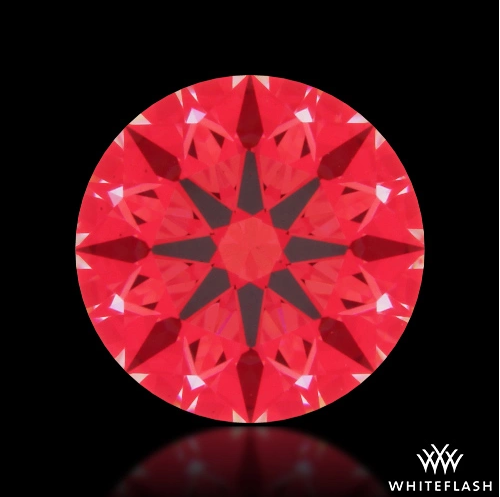This page contains references to diamonds or engagement rings from different companies. Sometimes I do receive a commission when you click on links and buy the products.
The principle of the Ideal Scope tool is based on the findings and developments of the Japanese scientist, Okuda, in the 1970’s. Okuda developed ways to assess diamond light performance by using magnified scopes and colored reflectors.

Image courtesy of Ideal-Scope.com
How to Read an Ideal-Scope Image
Interpreting an ideal scope image is fairly simple and is a key indicator of the diamond’s ability to return light and other aspects of the diamond’s cut quality and symmetry.

Image courtesy of Ideal-Scope.com
This reference chart taken from the Ideal-Scope website shows how the Ideal-Scope images can be interpreted and used to make informed decisions when buying a diamond.
- Areas of black indicate light returned at the highest angles. The Ideal-Scope presents as dark because the light from directly above the diamond is blocked by the camera (obscuration).
- Red areas indicate the brightest light being returned effectively to the eye.
- Pink areas indicate a less intense light return.
- White or greyish areas indicate light leakage; light that is escaping from the pavilion of the diamond and not being returned to the eye.
What to Look For
Diamonds of optimum cut quality will be presented through the ideal scope as an abundance of red, minimal white, or grey areas and a symmetrical patterning of black arrows from the center of the diamond. Average cut diamonds will show areas of pink and grey and also some white light leakage, A poorly cut diamond will show large areas of white indicating light leakage and a chaotic pattern with little to no symmetry.
The Ideal-Scope image can also give an impression of the proportions and symmetry of the diamond. Optical symmetry can be read in the Ideal-Scope images as a sharp pattern of arrows in the crown, while good proportions can be seen through a strong light return (red areas).
Contrast and Light Leakage
Contrast is an essential factor in creating the distinct ‘twinkle’ that a diamond has. This twinkle is known as scintillation and is created by the necessary dark areas of obstruction which balance with the areas of light. This contrast gives a blinking effect and in the right amounts, it contributes to the beauty of a diamond.

Image courtesy of Whiteflash
This Ideal-Cut diamond from the in-house A CUT ABOVE® diamonds by Whiteflash, shows positive areas of white that form a uniform pattern around the perimeter of the diamond. This is an example of a small amount of unreturned light contributing to the contrast within a diamond and should be interpreted as a positive when seen in an Ideal-Scope image.
Diamond Reflectors and ASET Technology
Although an older method for assessing light performance in a diamond, reflectors continue to be a simple and reliable tool that can give helpful insight with little need for extensive technical knowledge. The AGSL (American Gem Society Lab) advanced this technology with their creation of the ASET device (Angular Spectrum Evaluation Tool). The ASET can provide a more in-depth analysis of how the diamond is handling light. The ASET framework also works in conjunction with the AGS light performance grading system – a precise, computerized grading system based on the ASET.
Are ASETs Issued as Standard?
As cut quality and light performance play such a crucial role in the beauty of your diamond, the Ideal Scope is an excellent place to begin when analyzing your diamond. The images are easy to interpret and can indicate areas of light leakage that might be missed when viewing the diamond (or a high res image) with an untrained eye however many companies still fair to provide them, the table below shows what’s available from some selected vendors:
| Whiteflash | Blue Nile | James Allen | Brilliant Earth | Ritani | |
|---|---|---|---|---|---|
| HD Video Imaging |
✓ |
✓ |
✓ |
✓ |
✓(only on request) |
| Diamond Image |
✓ |
✓ |
✓ |
✓ |
✓(only on request) |
| Ideal Scope |
✓ |
✕ |
✕ |
✕ |
✕ |
| Hearts & Arrows |
✓ |
✕(on some diamonds) |
✕(on some diamonds) |
✕ |
✕ |
| Sarine Report |
✓ |
✕ |
✕ |
✕ |
✕ |
| ASET Map |
✓ |
✕(on some diamonds) |
✕(on some diamonds) |
✕ |
✕ |
Final Thoughts
In wrapping up our exploration of the Ideal Scope and its invaluable role in assessing a diamond’s light performance, it’s clear that this tool is more than just an accessory; it’s a critical asset for anyone looking to invest in a diamond. By providing insights into how well a diamond reflects light, the Ideal Scope enables buyers and enthusiasts alike to gauge a diamond’s brilliance and fire with precision and confidence.
Understanding the nuances of what makes a diamond sparkle isn’t just for gemologists; it’s for anyone with an appreciation for beauty and a desire to make informed decisions. Whether you’re a first-time buyer or a seasoned collector, leveraging the Ideal Scope can elevate your diamond selection process, ensuring you choose a gem that not only meets but exceeds your expectations.
As diamonds continue to evolve, tools like the Ideal Scope remain at the forefront, empowering consumers with knowledge and insight. Remember, the beauty of a diamond lies in its details, and with the Ideal Scope, you’re equipped to uncover and appreciate those details like never before. Embrace this tool in your journey to finding the perfect diamond, and let it guide you to a choice that sparkles as brightly as your love and aspirations.

Richard Jenkins, The Diamond Guru
Get free assistance from the Diamond Guru today. You’ll be glad you did!
- Secure the best quality diamond for your budget.
- Don’t pay over the odds for your diamond ring.
- Have peace of mind that you didn’t get ripped off.
Have a Question? Contact us now…

